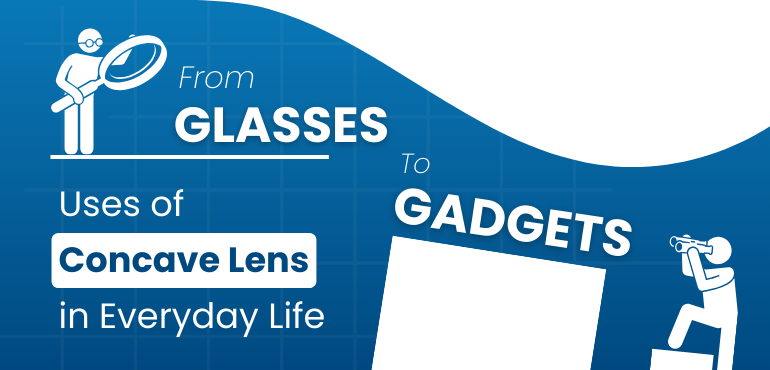
Concave lenses may not be as widely discussed as their convex counterparts, but their applications are diverse and significant in everyday life. These lenses are essential in various optical devices and have a unique set of properties that make them indispensable in multiple fields, from corrective eyewear to high-tech scientific instruments. This article provides a practical overview of concave lenses, diving into their properties, types, and everyday uses.
What is a Concave Lens?
A concave lens, also known as a diverging lens, is an optical lens that is thinner in the center and thicker at the edges. Unlike convex lenses, which converge light rays to a focal point, concave lenses spread out or diverge the light passing through them. This diverging nature makes concave lenses ideal for applications where reducing the focal length and controlling light diffusion are essential.
Concave lenses typically have a negative focal length because the light rays diverge away from the center after passing through the lens. This characteristic results in a virtual, diminished, and upright image when viewed through a concave lens. These properties are particularly useful in specific applications where minimizing image size or controlling the direction of light is needed.
The Formula of Concave Lens
The lens formula for a concave lens is used to determine the nature of the image it creates and to locate its position. This formula is essential for understanding how concave lenses function. The formula is as follows:
1/f = 1/v + 1/u
where,
‘f’ = the focal length
‘v’ = distance of the image
‘u’ = distance of the object
In this case, the focal length is negative because a concave lens diverges light rays, causing them to appear to originate from a virtual focal point on the same side as the object.
Properties of Concave Lens
Concave lenses possess distinct optical properties that differentiate them from convex lenses. Understanding these properties is crucial for identifying their practical applications:
- Diverging Nature: The most fundamental property of a concave lens is its ability to diverge light rays that pass through it. Parallel rays of light spread out after passing through the lens, creating a virtual image that appears to originate from a point behind the lens.
- Negative Focal Length: Concave lenses have a focal point located on the same side of the lens as the incoming light rays. This results in a negative focal length, which is why they are often referred to as “negative lenses.” The virtual image formed by the lens cannot be projected onto a screen, making it ideal for specific optical applications.
- Thin Center, Thick Edges: A concave lens is shaped with a thinner center and thicker edges, causing light rays to refract outward. This shape is essential for the lens’s diverging ability and determines its effectiveness in various devices.
- Virtual and Diminished Images: The images produced by concave lenses are virtual, meaning they cannot be captured on a screen, and they are smaller than the actual object being viewed. These characteristics make concave lenses ideal for magnifying objects or reducing the size of the image in certain situations.
- Non-Inverting Images: Unlike convex lenses, concave lenses do not flip or invert the image. Instead, they create an upright, albeit smaller, image of the object being observed.
These properties make concave lenses highly specialized and useful in fields like optics, medicine, and photography.
Types of Concave Lens
Concave lenses come in different shapes and configurations, each suited for specific applications. While all concave lenses share the same basic properties, the shape of the lens’s surface can affect its performance. The three main types of concave lenses are:
Biconcave Lens
A biconcave lens is curved inward on both sides, making it symmetrical. This type of concave lens is often used in optical systems where precise light divergence is required, such as in laser beam shaping or expanding light beams in scientific instruments.
Plano-Concave Lens
A plano-concave lens has one flat side and one inwardly curved side. It is typically used in devices where light needs to be dispersed in a controlled manner, such as in beam expanders, microscopes, and optical communication systems. The flat side allows for easy integration with other optical components.
Convexo-Concave Lens
Also known as a meniscus lens, a convexo-concave lens has one convex (outwardly curved) side and one concave side. This lens type is used when a balanced combination of divergence and convergence is needed. These lenses are often found in advanced imaging systems and certain types of eyeglasses to correct vision.
Each type of concave lens is designed to meet specific requirements, ensuring optimal performance for its intended application.
Uses of Concave Lens
Concave lenses play a crucial role in a variety of everyday devices and technologies. While they may not always be visible, their impact on our daily lives is significant. Here are some common uses of concave lenses:
- Eyeglasses for Nearsightedness: Concave lenses are frequently used in eyeglasses to correct nearsightedness (myopia). In individuals with myopia, light entering the eye focuses in front of the retina, causing distant objects to appear blurry. Concave lenses diverge the incoming light rays, allowing them to focus correctly on the retina and enabling the wearer to see distant objects more clearly.
- Cameras and Photography: Concave lenses are used in certain camera lens systems to control light dispersion and reduce distortions, such as chromatic aberration. They help in expanding the light rays to create a clear and accurate image, especially when used in combination with convex lenses. Many high-end camera systems incorporate concave lenses to improve image quality.
- Laser Devices: In laser technology, concave lenses are used to expand laser beams. Since concave lenses diverge light, they are often employed in laser systems to spread the beam and reduce its intensity, making it easier to focus or shape the laser light for specific tasks.
- Flashlights: Concave lenses are used in flashlights to spread light evenly. By diverging the beam, concave lenses ensure that the light covers a larger area, making them ideal for applications where wide, consistent illumination is needed, such as in camping lights or emergency torches.
- Peepholes in Doors: Peepholes, or door viewers, utilize concave lenses to give homeowners a wide field of view. The lens allows users to see a large area outside their door from a small opening, ensuring better security and convenience.
- Binoculars and Telescopes: While convex lenses are the primary lenses used in binoculars and telescopes, concave lenses play a crucial supporting role in refining the image. They help in correcting distortions and spreading the light more evenly, making the final image clearer and more focused.
- Optical Instruments: In various optical instruments, such as microscopes and telescopes, concave lenses are used to manipulate light and improve focus. These lenses help scientists and researchers observe minute details by diverging light in specific ways, enhancing image clarity.
Conclusion
Concave lenses, often overlooked compared to convex lenses, are vital in many daily applications. They correct vision, shape laser beams, and control light divergence, making them essential in optics and photography. Their unique characteristics—such as diverging light, having a negative focal length, and forming virtual, diminished images—make them ideal for specialized uses. Understanding the properties and applications of concave lenses enhances our appreciation for the technology that enriches our lives.








